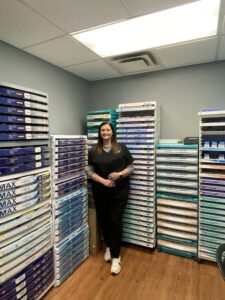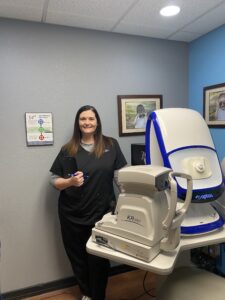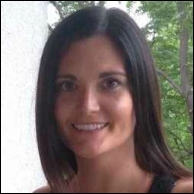
Dr. Kurtis in the contact-lens supply room in her office. She says that embracing new technology in contact lenses, and then educating patients about those new options, is among the practice improvements that have most helped patients and increased profitability.
By Sara Kurtis, OD
April 26, 2023
Practice improvements can greatly heighten your ability to care for patients and grow your patient base and profitability. Here are a few upgrades we made to how we operate and what we invest in that has helped patients significantly while, altogether, enabling us to add at least $150,000 annually to our revenues.
Embracing New Technology in Contact Lenses
When I took over my practice 18 years ago, the doctor who was in my office before me took a one-size-fits-all strategy to fitting contact lenses. Patients who had dry eye, patients who wanted to sleep in their lenses, every patient, was fit in the same brand of contacts, which at that time was an older-material hydrogel lens.
I was seeing a high number of patients who were dissatisfied, and we were experiencing a high dropout rate. It was at this point, early in my career, that I decided I needed to embrace new contact-lens technologies and treat each patient as an individual and fit them in the most appropriate contact. It is easy to focus solely on prescribing the lenses that are the most profitable, or just the ease of having one lens as your “go-to,” but every patient deserves the best possible experience with their contact lenses.
I wanted to give every patient the best possible outcome with their contacts to ensure they received the best of care, became loyal patients and referred friends and family to me.
The first thing I did was form good relationships with my contact-lens reps, so I could learn about all the new lenses available and be able to offer them to my patients with confidence. I learned how to excel at fitting multifocal contact lenses, so I would be able to offer them to more patients and help prevent dropouts. I talked to patients about their lifestyles and the obstacles they faced with their current contacts. If patients had tried contacts in the past and dropped out, I educated them that there are newer options that might address those issues and would allow them to wear contacts again.
This approach opened up my dialogue with patients, so I could learn more about the contact-lens needs they had that were not being met.
Profitability increased with this strategy in a couple of ways. Many patients who were scheduled as only wanting an exam for glasses ended up also getting contact-lens fits. This enabled me to increase exam fees by over 50 percent for these patients. Another factor that increased profitability was the increase in the number of daily disposable contacts that I was fitting. These patients came back more frequently for exams, were happier overall with their contacts and generated more referrals. I currently fit 65 percent of patients in daily disposable contacts.
Adding Advanced Diagnostic Instrumentation Technologies
The first piece of diagnostic equipment I purchased 10 years ago was an OCT/retinal camera combo unit. I decided on this unit because I wanted to be able to do more comprehensive medical eyecare. I was referring numerous patients out for glaucoma evaluations and other retinal conditions that I could have been diagnosing and treating myself, if only I had the proper instrumentation.

Dr. Kurtis in one of her practice’s pre-testing rooms. The advanced technology she has invested in has changed the level of medical eyecare she can provide while also helping the practice to generate greater profitability.
I met with reps from several different companies, and had them bring demo units to my office. I researched what insurances would reimburse for the different CPT codes and analyzed how many procedures I would have to do to cover the cost of the equipment. Only after that research process did I decide on a unit and make a purchase.
The price of the first unit I purchased was $60,000. I financed it through my local bank. The companies that sell you the equipment will make it easy for you to finance it, but you must be careful. Many of the companies that finance optometry equipment will assess all the interest upfront, so even if you want to pay it off early, you will still end up paying more. And, typically, when they offer you no payments for six months, the loan will still accrue interest during this time.
For instance, if you purchase a piece of equipment that’s $50,000, you could end up paying $65,000 in the long run. Always read the fine print. You also can negotiate with the companies on the equipment. The initial price they give you does not necessarily have to be the price you pay. If you are hesitant about spending that amount of money, and unsure if you can make it profitable, ask the rep if they have any refurbished equipment or demo units at a lower price. This can often get the equipment in your office at a lower initial cost. You can get good deals if you wait until the end of their fiscal year. Equipment companies also frequently have “show specials” when large conventions are taking place.
Adding advanced instrumentation will have a profound impact on patient care. At my office, I currently have the Maestro 2 OCT from Topcon, Optomap wide-field camera, Oculus Keratograph 5M and the Chronos and CV5000 digital refraction systems from Topcon. Before the patient even sits in my exam chair, they could have a wide-field retina photo, an OCT scan of macula and optic disc with macular thickness analysis, ganglion cell complex analysis, nfl analysis, a preliminary refraction with BCVA and a non-invasive tear breakup time. This allows me to make sure nothing is overlooked when assessing the health of the patient’s eyes, even when they think they just need new glasses. It can also save the patient time and additional appointments when I am able to know with confidence if a referral is warranted.
After purchasing each piece of equipment, I have seen a significant increase in profitability. With the OCT and the Optomap, I can offer screening photos and OCTs to patients for a fee upfront. If I need to order further testing, I can bill the patient’s medical insurance plans. This can also generate more medical office visits for managing different ocular conditions.
Finding Out What other ODs in My area Were NOT offering & Asking for Referrals
Once you have established an increased level of care, you can continue to expand your practice with referrals from optometric colleagues.
Talk to other doctors in your area, find out what they are offering that you are not, and what you offer that they do not. This could include fitting scleral contact lenses, treatment/management of glaucoma, new technology in dry eye treatments or vision therapy, for example. You can also ask for referrals from other types of doctors in your area. I have reached out to local rheumatology practices to let them know we are accepting referrals for ocular testing for plaquenil patients.
Other Articles to Explore
When asking for referrals from rheumatologists, I put together a small packet with information about the ocular testing that is the standard of care for patients taking plaquenil, and that we have that testing available in my office. I also included a list of medical insurance plans that we accept.
This can offer patients more options and more accessibility to get the testing that they need. Where I live and practice, in Iowa, it is often a several-month wait to get an appointment with an ophthalmologist, but we are able to see patients within a couple weeks.
Generating referrals is a good strategy for increasing the profitability of the equipment you already have. In my office, a plaquenil exam can generate a few hundred dollars, for others offering new treatments in dry eye, that are all out-of-pocket, it many be over $1,000.
Think about the types of patients you are trying to reach and how you can reach them. For instance, if you want to start offering low-level light therapy (LLLT) or intense pulsed light (IPL) treatments, you may also want to reach out to a rheumatology practice and let them know the benefits that these procedures could have on their patients who suffer from dry eye associated with autoimmune disease. Or if you have technology like Neurolens, you should let all ODs in your area know that you have it and can treat patients with binocular vision challenges. They may have patients who would greatly benefit from that technology, but are unable to help with their current labs.
 Sara Kurtis, OD, is the owner of QC Family Eyecare in Davenport, Iowa. To contact her: sarakurtis16@gmail.com
Sara Kurtis, OD, is the owner of QC Family Eyecare in Davenport, Iowa. To contact her: sarakurtis16@gmail.com

























